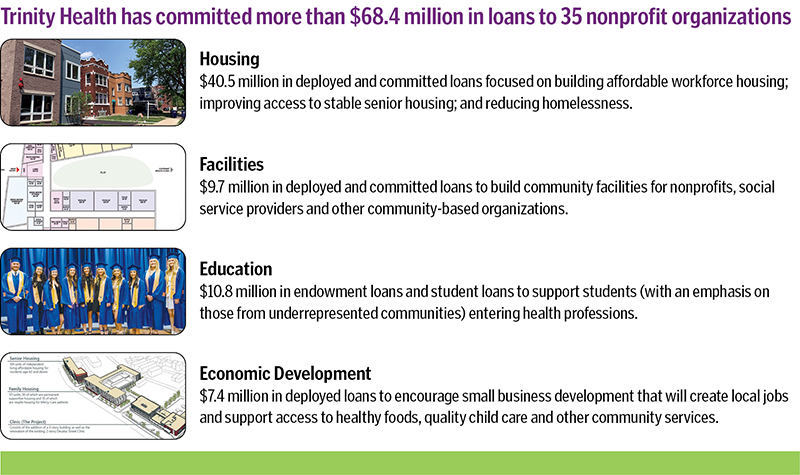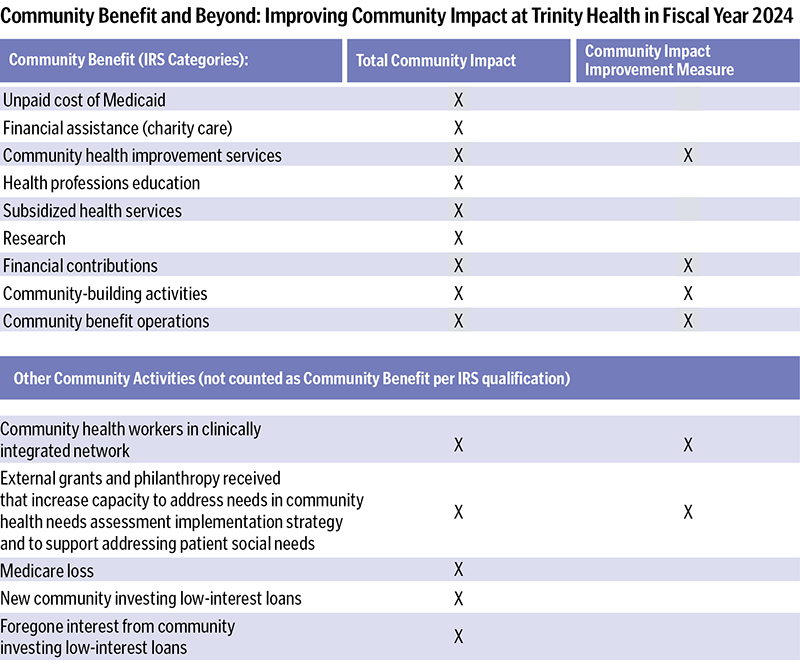Vice President of Community Health & Well-Being, Trinity Health
 Illustration by Cap Pannell
Illustration by Cap PannellNonprofit hospitals, representing nearly 60% of all U.S. hospitals, are enduring increasing pressure to demonstrate the value they offer to the communities they serve and whether (or not) they deserve their tax-exempt status. In fact, the Ways and Means
Subcommittee on Oversight held a hearing on tax-exempt hospitals and the community benefit standard in April 2023. During the hearing, Congressman Brad R. Wenstrup, R-Ohio, said: "Nonprofit hospitals should be providing a level of community benefit
that aligns with the value they are receiving from their tax-exempt status. Taxpayers who are on the hook for providing this benefit deserve to know what they are getting in return."1
In 1969, the IRS identified factors that can demonstrate community benefits but are not requirements. The Affordable Care Act of 2010 added additional requirements for nonprofit hospitals. The IRS does not have the authority to specify activities hospitals
must undertake and, as a result, tax-exempt hospitals have broad autonomy to determine the community benefits they provide.2
In September 2020, the Government Accountability Office recommended that Congress consider specifying what services and activities demonstrate sufficient community benefit. As of April 2023, Congress had not enacted such legislation. The increasing public
pressure, coupled with the Government Accountability Office's recommendations, should challenge all of us in Catholic health care to ensure we are not only demonstrating equivalent community benefit (to our tax exemption) but that we are demonstrating
measurable impacts in the communities we serve. Trinity Health is embarking on this challenge through an innovative community impact measure. This approach couples community benefit with additional indicators that measure work, education and investments
that achieve results above and beyond community benefit.
A CALL TO PRIORITIZE COMMUNITY NEEDS
Trinity Health and its regional health ministries are committed to delivering people-centered care and serving as a compassionate and transformative healing presence within our communities. As
a nonprofit health system, we reinvest profits back into the communities we serve and are committed to addressing the unique needs of each.
In fiscal year 2023 (July 1, 2022 – June 30, 2023), Trinity Health contributed $1.5 billion in community benefit spending to aid those who are experiencing poverty and other vulnerabilities and to improve the health status of the communities we
serve. Community benefit activities are intentional, strategic and address the social influencers and drivers of health identified in the community health needs assessments (CHNAs).
And yet, this was not our only community impact. In fiscal year 2023, we undertook other efforts — which involved investments of more than $209 million — that did not count toward community benefit:
- Covering unpaid Medicare costs.
- Anchor strategy work including:
- Local investing through low-interest loans to community partners.
- Impact hiring initiatives to ensure people of color and low-income community members have a direct pipeline to higher wage jobs.
- Local sourcing initiatives to increase the organizational spending with minority or women-owned business enterprises and to ensure they have pathways for system contracts.
- Investing in community health workers (CHWs) to ensure the needs of community members are met when working in value-based contracts with community partners.
The COVID-19 pandemic was a wake-up call to the nation about the severe inequities that exist. It was also a reminder of how racism is embedded in health care and why health disparities persist. In 2020, Trinity Health doubled down on our commitment to
dismantle racism and address the inequities that exist across the communities we serve. We declared racism a public health crisis and reimagined how we invest our community health resources. No longer could we sprinkle funding (or services) around
every community and believe that we were making an impact. We had to prioritize and focus our resources in places that have been historically disinvested. We needed to embed racial equity principles into how we design interventions, which includes
authentically engaging with community-based organizations and designing initiatives in collaboration with our community partners and residents.
SHIFTING COMMUNITY HEALTH & WELL-BEING INVESTMENTS TO DISMANTLE RACISM
Trinity Health's Community Health & Well-Being department leads the integration of social and clinical care integration, prioritizes investments in our
communities and strengthens our community benefit impact. Its purpose is to optimize health for those who are experiencing poverty and other vulnerabilities in the communities we serve. We dismantle oppressive systems, including racism, and build
community capacity and partnerships.
In 2020, the department partnered with the Diversity, Equity and Inclusion team to design a peer learning series — focused on building antiracist leaders within Community Health & Well-Being — that would advance our capacity to engage
equitably with our colleagues, patients and community members. Additionally, the department made a commitment that 80% of all community health funding would be focused on communities that were defined as "high priority." These communities were defined
as those representing populations that were more than 40% Black and/or Latino and where the average earnings for the ZIP code are at or below 200% of the federal poverty guideline — or 80% of area medium income. This includes both our grant
resources and our low-interest loans as part of our commitment to anchor strategies.
While the pandemic significantly impacted health care finances and the amount of our available funds for grants, it has not slowed loan commitments. In fact, since 2020, we saw a nearly 50% increase in allocation — $46 million to $68 million —
of low-interest loans to accelerate access to affordable housing, early childhood programming, food access and beyond.
We also launched the second round of our Transforming Communities Initiative3 in 2022 — funding nine multisector collaboratives to advance health and racial equity through policy, system and environmental change. Trinity Health did not
require an application to receive this funding — rather, we strategically awarded high-priority communities grant funding, coupled with national technical assistance support. Each community is funded for a planning phase and up to four years
of implementation. We are eager to learn from these nine communities how they form and structure their multisector collaboratives, identify the root causes of poor health in their communities and prioritize community-driven solutions. A national evaluation
is also in place to help Trinity Health and the broader health and public health community understand "what works" when it comes to community-driven solutions.
The Transforming Communities Initiative team in Springfield, Massachusetts, has a long-established multisector collaborative — called Live Well Springfield — that broadly gathers input from the community to identify needs and actively engages
a community advisory board comprised of residents. As one way to map potential community changes, an illustrator visually documented the discussion during a recent community advisory committee meeting. This approach helped to further identify the
root causes of homelessness in Springfield.
STRUCTURAL CHANGE
Since 2018, Trinity Health has elevated the role of executive leaders of Community Health & Well-Being in each of our twelve regional health ministries. These executive leaders are responsible for delivering
the Community Health & Well-Being strategy, and their teams lead the triennial CHNA and its implementation planning.
To further optimize these efforts, our peer learning series was specifically directed to leaders of our Transforming Communities Initiative, CHNAs and other leaders who engage with community partners and residents to understand how to collaborate equitably.
A significant focus of the peer learning series was developing comprehensive and community-engaged implementation strategies. We also emphasized to our teams the need to investigate all potential resources for funding support as the needs of our communities
have only continued to increase since the pandemic; and, if we focus on too many needs with limited resources, we will not make an impact.
Today, we are working together with other local health systems, public health and community-based organizations, and residents to identify solutions and use a collective impact approach over several years to deliver the necessary impact. One highlighted
success features Trinity Health Ann Arbor, Michigan Medicine, Chelsea Hospital and the Washtenaw County Health Department, who, after conducting collaborative needs assessments for many cycles, committed to collectively implement and fund initiatives.4
ADDRESSING PATIENTS' SOCIAL NEEDS
Since 2020, Trinity Health has consistently screened our patients for health-related social needs, such as transportation or food assistance. We developed a 10-question screening tool — embedded
in our electronic health record — that automatically pushes to patients via our patient portal and/or upon visit arrival if they have a qualifying visit or haven't had a screening in the past year. We also embedded a community resource directory5 — powered by Findhelp — to make it easy for providers and care team members to quickly navigate community resources available for a patient with an identified social need.

In fiscal year 2023, we screened nearly 700,000 patients, and almost 30% had at least one identified social need. The top three identified social needs across our communities are food access, financial insecurity and
social isolation. Our CHWs resolved nearly 7,500 social needs in fiscal year 2023.
COMMUNITY IMPACT MEASURE
There is increasing pressure and criticism of community benefit, however community benefit doesn't tell the entire story of how nonprofit health care impacts our communities. Community impact — as defined
by the Lupton Center — is the lasting change that a group of people can make. It's structural, not temporary. Rather than treating the symptoms of inequality, community impact refers to the tangible change to system-level issues.6
For the current fiscal year (July 1, 2023 — June 30, 2024), Trinity Health defined our total community impact and developed an improvement measure to increase it (see chart on page 27). Our community impact improvement measure focuses on increasing
investments in specific community benefit categories, noncommunity benefit investments, grant seeking, and assurance of comprehensive and accurate community benefit reporting.
Using Trinity Health baseline data, our goal is to achieve a 4% improvement in community impact from fiscal year 2023 and yield an additional $15 million in community impact.
To achieve this improvement, we've identified key drivers that will facilitate success:
- Standard community benefit training with increased frequency and intentional departmental focus across every hospital.
- Increase grant-seeking behavior and partnership with clinically integrated networks to grow and sustain CHWs to achieve our desired staffing of one CHW to every 2,000 Medicaid members. This will help demonstrate that our CHWs prioritize all socially
vulnerable patients irrespective of insurance status.
- Increase grant-seeking behavior and partnerships (including hospital cash contributions) to address needs outlined in CHNA implementation strategies.
- Increase partnerships with payers to cover interventions that support social and clinical care integration.
- Continued investment in Transforming Communities Initiative to advance health and racial equity in our communities.
According to County Health Rankings, a person's health is mostly impacted by the conditions in the community (social determinants of health); only 20% is due to medical care.7 Until the conditions in the communities we serve are safe and all
community members have access to high-quality education, health care, affordable food and housing, achieving improvements in health outcomes (individually or as a community) is not possible. This is why Trinity Health prioritizes connecting social
and clinical care and investing in the social influencers of health.

Trinity Health is committed to ensuring we comprehensively report all the community benefit happening across our system and its total community impact to fully demonstrate the service and support we provide in our communities.
JAIME DIRCKSEN is vice president of Community Health & Well-Being for Trinity Health.
NOTES
- "Hearing on Tax-Exempt Hospitals and the Community Benefit Standard," Committee on Ways and Means, April 26, 2023, https://gop-waysandmeans.house.gov/wp-content/uploads/2023/08/WEBSITE-April-26-2023-OS-Sub-Hearing-Transcript.pdf.
- "Tax Administration: IRS Oversight of Hospitals' Tax-Exempt Status," U.S. Government Accountability Office, April 26, 2023, https://www.gao.gov/products/gao-23-106777.
- "Transforming Communities Initiative," Trinity Health, https://www.trinity-health.org/our-impact/community-health-and-well-being/transforming-communities-initiative.
- Rylee Barnsdale, "Washtenaw County Hospitals Team Up to Assess Community Health Needs," Concentrate, September 27, 2023, https://www.secondwavemedia.com/concentrate/features/chna0697.aspx.
- "Community Resource Directory," Trinity Health, https://communityresources.trinity-health.org/.
- "How to Measure Community Impact," Lupton Center, https://www.luptoncenter.org/how-to-measure-community-impact/.
- Carlyn Hood et al., "County Health Rankings: Relationships Between Determinant Factors and Health Outcomes," American Journal of Preventive Medicine 50, no. 2 (February 2016): 129-135, https://doi.org/10.1016/j.amepre.2015.08.024.
TRINITY HEALTH CRAFTS UNIFIED MESSAGES ABOUT HOW IT HELPS COMMUNITIESPart of the community benefit and community impact work at Trinity Health includes meeting across departments to tell the story of this important work. It begins with in-house planning and education. Trinity Health Advocacy, Community Health & Well-Being, Mission, Marketing and Communications, Tax and Finance have been coming together for nearly a decade to craft our annual messaging on how to share the great work of our ministries.
We design skills training for executive leaders and others in these departments. The training provides all participants' talking points, sample PowerPoints and story cards of funded programs and initiatives and those who have been
helped. These can help when conducting advocacy efforts on behalf of Trinity and its community partners.1 Ministry leaders share their best practices on how to convey the community benefit story to legislators, businesses,
community organizations and the public. We want more people to understand our work, whether it's our community health worker initiative or our efforts to ensure safe, affordable housing, both being important factors in people's overall health. This skills training is provided
to ensure that our messaging is more proactive than reactive, though it also supports the leaders when local or state government questions the value of a hospital's tax-exempt status. NOTE - "Care for the Common Good: Housing for Health," Trinity Health, March 2020, https://www.trinity-health.org/assets/documents/advocacy/housing_for_health_march_2020.pdf.
|